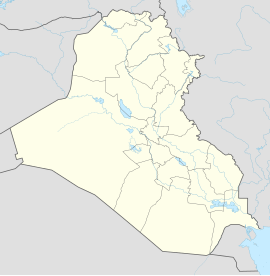Kufa
| Kufa | ||
|---|---|---|
| location | ||
|
|
||
| Coordinates | 32 ° 2 ′ N , 44 ° 24 ′ E | |
| Country |
|
|
| Governorate | Najaf | |
| Basic data | ||
| height | 30 m | |
| Residents | 127,876 (2005) | |
| The Great Mosque 2004 | ||
Kufa ( Arabic الكوفة, al-Kūfa ) is a city in Iraq . It is located on the banks of the Euphrates , around 10 kilometers northeast of Najaf in the Najaf province . The population is around 128,000 (as of January 1, 2005). The city was very important in early Islamic times. The so-called Kufic script is named after her, as is the Kufiyya headgear (Palestinian cloth ).
history
In pre-Islamic times, the region belonged to the sphere of influence of the Persian Sassanids , who were able to repel an attacking Muslim army in the vicinity of today's Kufa in 634.
Kufa was founded as Misr (Arab camp town) in 638 when 30,000 veterans were settled there (with the Badschīla being the largest tribal group). In the opinion of some, Kufa was the first actual “ capital ” of the Islamic empire, as numerous administrative institutions were also located there. Until the time of Uthman , however, followers of Musailima from the Banū Hanīfa tribe had their own mosque there.
The caliph ʿUmar ibn al-Chattāb installed the Prophet's companion ʿAmmār ibn Yāsir as governor of Kufa in 641. In 657 the fourth caliph ʿAlī ibn Abī Tālib made Kufa his capital. After his murder and Muʿāwiya's self- proclamation as caliph, Kufa became the center of the Alidian opposition to the Umayyads . During the Second Civil War , the city made itself independent for almost two years (685-687) under al-Muchtār ibn Abī ʿUbaid .
Around the middle of the 8th century, the Hanafi school of law expanded from Kufa . At the same time, Kufa was an important center of the Schia . After the troops of Abū Muslim had taken the city and eliminated the Umaiyads in August 749 , the Shiite leader Abū Salama was installed as governor of the city. He made an effort to Aliden to secure the Caliphate, but these attempts were unsuccessful because the various Aliden he anschrieb did not react, but but the Abbasids made their claim to the throne in law. On November 28, 749, Abu l-Abbas as-Saffah was proclaimed the new caliph in the great mosque of Kufa, which marked the transition of power from the Umaiyads to the Abbasids.
In the 9th century the philosopher al-Kindī worked in Kufa .
Personalities
- Buhlul (around 749-805)
See also
literature
- Hisham Djait : al-Kufa. Naissance de la ville islamique (Islam d'hier et d'aujourd'hui; Vol. 29). Maisonneuve et Larose, Paris 1986, ISBN 2-7068-0927-2 .
- Josef van Ess : Theology and society in the 2nd and 3rd centuries of the Hijra. A History of Religious Thought in Early Islam, Vol. 1 . De Gruyter, Berlin 1991, ISBN 3-11-011859-9
- Najam Iftikhar Haider: The origins of the Shīʿa: identity, ritual, and sacred space in eighth-century Kūfa. Cambridge 2011.
- Michael G. Morony: Iraq after the Muslim Conquest (Princeton Studies on the Near East). University Press, Princeton, NJ 1984, ISBN 0-691-05395-2 , pp. 239ff.
- Yaron Friedman: "'Kūfa is Better' The Sanctity of Kūfa in Early Islam and Shī'ism in Particular" in Le Muséon 126 (2013) 203-237.
Individual evidence
- ↑ Cf. van Ess: Theologie und Gesellschaft, Vol. 1 , p. 4.
- ↑ See H. Reckendorf : ʿAmmār ibn Yāsir . In: The Encyclopaedia of Islam. New Edition , Vol. 1 , p. 448b.
- ↑ Cf. Gernot Rotter : The Umayyads and the Second Civil War. 680-692 (Treatises for the customer of the Orient; Vol. 45,3). Verlag Franz Steiner, Wiesbaden 1982. pp. 93-106.
- ↑ Cf. van Ess: Theologie und Gesellschaft, Vol. 1 , p. 149.
- ↑ See Heinz Halm: The Schia . Scientific Book Society, Darmstadt, 1988. p. 32.
- ↑ The entire work comprises six volumes.

